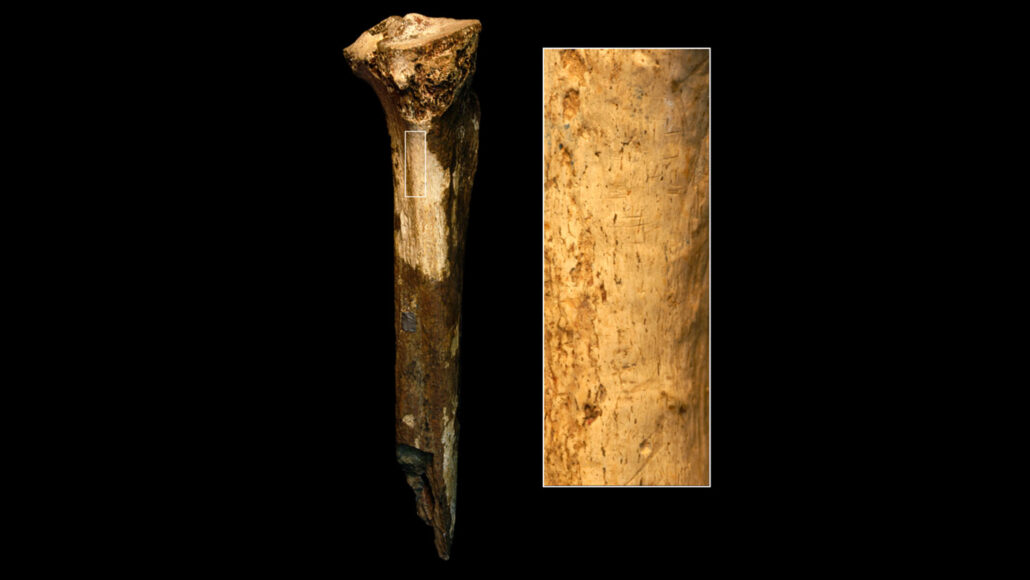Around 1.45 million years ago, hominids may have engaged in cannibalism based on fossil evidence.

A 1.45-million-year-old hominid leg fossil sports previously unrecognized evidence of our ancient evolutionary relatives butchering and possibly eating one another, a new study claims.
An ancient individual used a stone tool to make nine incisions on the fossil, which preserves the shin and knee. Analyses of 3-D models of these marks peg them as resembling damage produced by stone tools rather than by large predators’ bites or by animal trampling, researchers report June 26 in Scientific Reports.
Those incisions are the oldest convincing example of such butchery and possibly cannibalism among ancient hominids, says paleoanthropologist Briana Pobiner of the Smithsonian Institution in Washington, D.C. But there’s debate about that interpretation.
Pobiner first examined the incised leg bone while studying fossils held at the Nairobi National Museum in Kenya. She wanted to identify which nonhuman predators hunted and ate ancient hominids. But marks on the leg bone looked to her like butchery damage.
Pobiner sent molds of 11 incisions on the fossil to paleoanthropologists Michael Pante of Colorado State University in Fort Collins and Trevor Keevil of Purdue University in West Lafayette, Ind. The pair created 3-D scans of the bone marks and compared them with 898 bone marks known to have been made by stone cutting tools, stone pounding implements, the teeth of crocodiles, lions and other nonhuman predators, or cows trampling the ground (SN: 11/6/17).
Nine marks closely matched stone-tool damage, Pobiner says. The other two marks resulted from the bite of a big cat, perhaps a saber-toothed cat.
No consensus exists on the species identity of the ancient leg fossil. It might represent Homo erectus, H. habilis or a relatively small-brained species called Paranthropus boisei, Pobiner and colleagues say. There is also no way to tell whether a hominid from the same species or a different species left stone-tool marks on the leg fossil.
The incisions on the fossil cluster around a spot where a calf muscle attached to bone, consistent with the removal of a chunk of flesh, Pobiner says. Reasons for that act remain hazy, especially with only a single, fragmentary bone in hand. “We assume the intention of whichever [hominid] inflicted the cut marks was simply to cut off meat from the bone to eat it, based on hunger,” Pobiner says.
Zooarchaeologist Raphaël Hanon of Wits University in Johannesburg agrees. Cutting into the fleshy part of a lower leg probably reflected a need for food rather than a ritual act of some kind, says Hanon, who was not part of Pobiner’s team. There is no way to know whether flesh from meatier body parts, such as the shoulder and upper leg, was also removed, he says.
But stone-tool incisions on a partial leg bone do not provide enough evidence to determine whether hunger motivated flesh removal, counters zooarchaeologist Palmira Saladié of the Catalan Institute of Human Paleoecology and Social Evolution in Tarragona, Spain. Pobiner’s findings may reflect scenarios such as cannibalism to supplement other food sources, some sort of ritual practice that did not include cannibalism or the consumption of a defeated enemy following a fight between groups, suggests Saladié.
Archaeologist Yonatan Sahle of the University of Cape Town in South Africa agrees that the interpretation remains up in the air. Although Stone Age cannibalism may have occurred, “the present evidence is not strong enough to enable such an inference,” he says.
Get great science journalism, from the most trusted source, delivered to your doorstep.
Further complicating matters, the original context of the leg fossil is unknown. It was found on the surface of a site in northern Kenya after coming loose from eroding sediment. The fossil’s age estimate derives from its position just above a volcanic ash layer dated to between around 1.5 million and 1.6 million years ago. Researchers have thus presumed that the leg bone originally rested in sediment slightly younger than that ash deposit.
A possible earlier case of a butchered hominid, reported in 2000, also triggered debate. Researchers described incisions on a partial upper jaw found at a South African site — with age estimates ranging from 1.5 million to 2.6 million years old — as having resulted from slicing through a muscle to remove the lower jaw. But Hanon and colleagues have argued that animal trampling or accidental rubbing of the fossil against jagged rocks before it was excavated could have produced the incisions.
Pobiner’s group did a good job of excluding such factors as causes of nine of the 11 incisions on the hominid leg fossil, Hanon says. There is a “very high probability” that a hominid used a stone tool to create those ancient marks, he concludes.
But even if further research strengthens that probability, such evidence falls far short of demonstrating butchery or cannibalism, says Tim White, a paleoanthropologist at the University of California, Berkeley, who has long studied skeletal clues to cannibalism (SN: 1/2/93). White calls the Kenyan fossil “an interesting scientific curiosity that changes nothing of significance.”
Our mission is to provide accurate, engaging news of science to the public. That mission has never been more important than it is today.
As a nonprofit news organization, we cannot do it without you.
Your support enables us to keep our content free and accessible to the next generation of scientists and engineers. Invest in quality science journalism by donating today.




